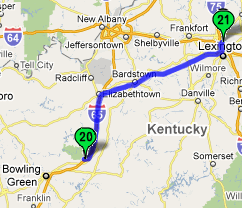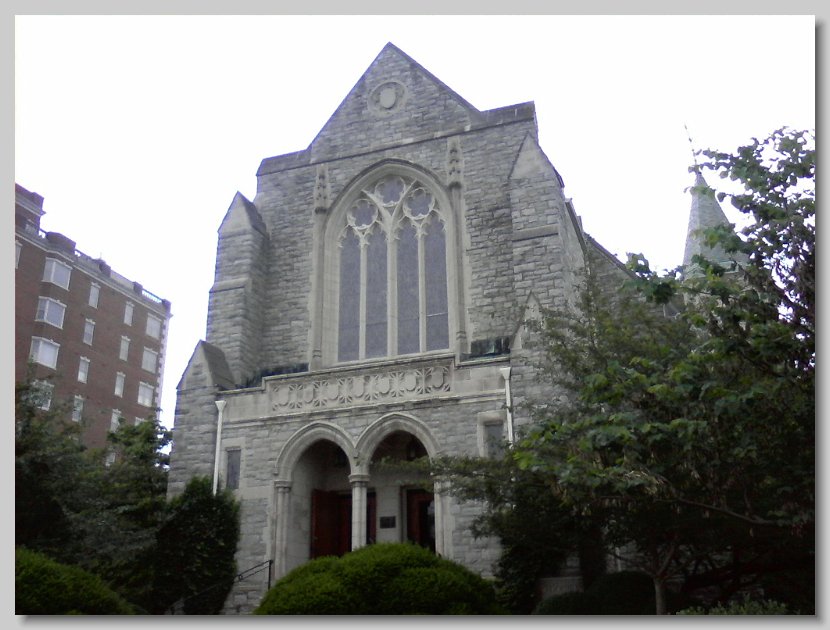
May 21-June 9 - Kentucky
Just 40 miles south of Cave City is Bowling Green KY, hometown of the Corvette. Not only is the GM factory that makes all the Corvettes there, but right across the street is the National Corvette Museum - pretty much hallowed ground for Corvette owners and wanna-bees. We toured the museum and wanted to tour the factory as well, but turns out you need to make your factory tour reservations nine days out, and by the time we found that out, we didn't have time. But Bowling Green had a couple of other things we liked - a Culvers Frozen Custard store (our first since Texas) and a Speedway Gas Station. A couple years ago we were gifted a Speedway Gasoline Gift Card (thanks, Adam and Amber), and this is the first time since that we've been in Speedway territory. We patronized both places. Cave Country is all about caves, and we spent a lot of time underground. The geology of the area is what makes all those caves possible. It's called a Karst region - a topography made of layers of soluble bedrock such as limestone. Water seeping between the layers dissolves the rock, leaving caves and sinkholes. Usually the caves are wet, but Mammoth Cave is mostly dry, the result of a surface layer of about 50ft of sandstone.
Our guide for the first tour was named Bob Cetera (bet he's glad his folks didn't name him "Ed"), a retired high school drama teacher from the Chicago area, about our age. He's also a talented photographer, and several of his images are sold on post cards in the park stores. He's a wealth of information about almost anything, and a delight to chat with, which we did on a couple of occasions. A few miles north of Cave City is the town of Horse Cave, home to the American Caving Museum, operated by the American Cave Conservation Association, which also offers tours of the Hidden River Cavern. The cave is right in the middle of town, and is a remarkable example both of what people can do to totally mess up something like that, and also of what the cave can do to heal itself once you get people to leave it alone. Being in the middle of the town, the cave naturally became the town septic tank, and eventually the waste killed all the life in the cave. For over 50 years, the stench rising from the cave permeated the town, especially in summer. Finally, the EPA got involved and helped the town get a decent sewer system. And the cave then cleaned itself, over about 10 years, with the aid of a few floods and a very fast moving river that runs through it. Neat story, neat cave.
We also toured the Lost River Cavern, on the south side of Bowling Green. It's a relatively new cave, geologically speaking, accessible only by water, and the tour is a boat ride. Unique for us, and fun. On June 2, we stowed our stuff and headed across the state to Lexington (21). Lexington is the heart of Kentucky Bluegrass Country. We looked up "Bluegrass". Bluegrass isn't usually blue. It's almost always green like normal grass. But if you don't cut it and let it grow to full height (about 3 feet) and then let it blossom, the flowers are blue. So now we know.
Our visit was dulled some when we were setting up the RV after arrival. As we were setting up, one of the hydraulic hoses in our levelers burst. Without hydraulic pressure, we couldn't level the coach or extend the slide. Plus, there was hydraulic fluid all over the pavement. Kitty litter took care of the fluid on the pavement. Getting the hose replaced or the leak fixed was another story. There are only two RV dealers in this town. Both were booked solid in their service department until well after we were due to leave. One of them found one of the guys in the service department willing to come out and take a look on his own time. Turned out to be the young son of the owner, who came out, looked the situation over, and said he'd be back the next day with the parts to fix it. But he never came back. On our second call to the dealership, found out that the young man is not highly motivated nor very well organized, but being the boss's son there isn't much the service manager can do about it. A couple more calls and we found a truck and trailer service company, and they came out within hours and replaced the hose. Shoulda called them first instead of wasting two and a half days waiting for somebody to show up. We came in on Wednesday, and it was Friday evening before we were able to finish setting up. We didn't know then about a new hydraulic problem. But that's for our next report.
Several historical figures came from Lexington. Mary Todd Lincoln, wife of Honest Abe, was born and raised here, and we were able to tour her childhood home. The tour is mostly about the life and legends of Mary Todd Lincoln, with the house as a delightful background. We couldn't take any pictures inside the building, so you'll have to trust us when we say it was lovely. Probably the most favorite son of Lexington is Henry Clay, the Great Compromiser. Clay was a lawyer turned politician turned statesman. Among other distinctions, he is the only US Congressman ever elected Speaker of the House on the first day of his first term. He was one of the most outspoken proponents of starting the War of 1812, and was also given much of the credit for negotiating the end of that war. He served in the US Senate, ran for (and lost) the Presidency 3 times, and served a term as Secretary of State to President John Quincy Adams. He was also a gentleman farmer, raising horses and cattle, and a portion of his estate, Ashland, is tourable. The home on the estate was rebuilt after Clay's death by his son, following the same plans, but somewhat more luxurious. The original home had been damaged by earthquakes, and Clay couldn't afford to rebuild it during his lifetime. Again, no pictures inside the home, and the tour is as much about the life of Clay as it is about the house. A very nice afternoon.
A few miles southeast of Lexington is the Shaker Village of Pleasant Hill, a preserved and restored Shaker There are many parts of Kentucky we didn't visit. We'd like to spend some time in Louisville, but RV parking is a challenge near any big city. Likewise, we didn't get to any of the legendary bourbon distilleries, visit the original Kentucky Fried Chicken store, or go see if there are really any Dukes in Hazzard. Maybe next time. Judy's culled our Kentucky pictures down to about 117 for our slideshow. You can see them here.
|
 This was our first visit to Kentucky in our motorhome, although we'd visited on a day trip a few years ago. We always try to have firm reservations for holiday weekends, to make sure we have someplace to stay, and for Memorial Day we chose Cave City KY (20), the heart of Cave Country. We stayed 12 nights at the Singing Hills RV Park just outside the entrance to Mammoth Cave National Park, and took five different cave tours while we were there.
This was our first visit to Kentucky in our motorhome, although we'd visited on a day trip a few years ago. We always try to have firm reservations for holiday weekends, to make sure we have someplace to stay, and for Memorial Day we chose Cave City KY (20), the heart of Cave Country. We stayed 12 nights at the Singing Hills RV Park just outside the entrance to Mammoth Cave National Park, and took five different cave tours while we were there. We worshipped at the Second Presbyterian Church of Lexington, a wonderful gothic-style church with great stained glass, huge pipe organ and a cross-shaped sanctuary. After the Civil War, when the Presbyterian Church split into Northern and Southern organizations, First Pres of Lexington chose to affiliate with the Southern church. So the folks who wanted to stay with the Northern church formed Second Pres. Today, of course, the Presbyterian Church is again united, but both churches remain and, apparently, thrive. First Church has about 800 members, Second about 1000. They both claim to be the "original" Presbyterian church in town.
We worshipped at the Second Presbyterian Church of Lexington, a wonderful gothic-style church with great stained glass, huge pipe organ and a cross-shaped sanctuary. After the Civil War, when the Presbyterian Church split into Northern and Southern organizations, First Pres of Lexington chose to affiliate with the Southern church. So the folks who wanted to stay with the Northern church formed Second Pres. Today, of course, the Presbyterian Church is again united, but both churches remain and, apparently, thrive. First Church has about 800 members, Second about 1000. They both claim to be the "original" Presbyterian church in town.